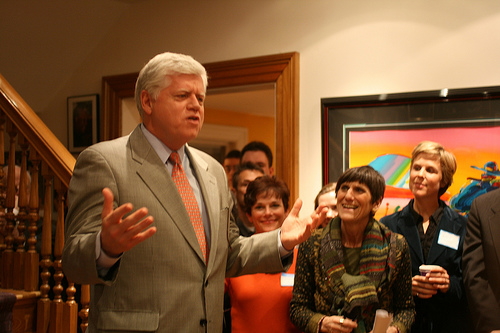217-205: Waxman-Markey Clear Key House Hurdle (NYT/AP)
A Closer Look at Those Climate Bill Giveaways
A Closer Look at Those Climate Bill Giveaways (The Vine – TNR)
G.O.P.'s Inglis on Preaching Carbon Taxing to Republicans
G.O.P.’s Inglis on Preaching Carbon Taxing to Republicans (The Energy Collective)
Markey-Waxman Bill Summarized
Markey-Waxman Bill Summarized (Cybercast News Service)
New Larson Bill Raises the Bar for Congressional Climate Action
Carbon taxing to safeguard Earth’s climate took several major steps forward — politically and intellectually — with the introduction yesterday of the America’s Energy Security Trust Fund Act of 2009 by Rep. John B. Larson, chair of the House Democratic Caucus and fourth-ranking Democrat in the House of Representatives.
The new bill builds and improves on Rep. Larson’s 2007 bill with these provisions:
- The first-year tax rate is $15 per ton of carbon dioxide.
- The rate rises by $10/ton per year.
- After five years, that increase rate is automatically bumped up to $15/ton if U.S. emissions stray from an EPA-certified glide path to cut emissions by 80% from 2005 levels in 2050.
- To protect domestic manufacturers, the bill authorizes the Treasury Department to impose a “carbon equivalency fee” on carbon-intensive products imported from non-carbon-taxing nations.
- Clean-tech R&D and investments are eligible for $10 billion a year in tax credits.
- Impacted workers and industries are eligible for transition assistance of $7.5 billion in the first year; this is phased out after year 10 but still totals $41 billion.
- All other revenue is tax-shifted to Americans via reductions in payroll taxes.

Rep. Larson, a member of the powerful, tax-writing Ways & Means Committee, appears to have crafted his new bill to counter most if not all salient objections to carbon taxing:
-
To the insistence on emission guarantees: the Larson bill responds to the “quantity-certainty” objection by virtually guaranteeing deep emission cuts. Emissions would fall to 25% below 2005 levels in 2022, according to CTC’s conservative carbon tax-impact model. If that’s insufficient, the automatic tilt to a $15 annual increment will push the 2022 reduction percentage higher (we estimate to 30%), with cuts continuing after. The average annual decline rate in that scenario matches the 2% target rate in most cap-and-trade proposals and kicks in much more quickly, due to the tax’s shorter lead time.
- To concerns about “tax-and-spend”: over the first ten years, 96% of revenues would be returned to U.S. families. The recapture percentage reaches 99% in year 15.
- To fears of eroding U.S. competitiveness: the payroll-tax reductions provide the much-sought “double dividend” of stimulating the economy while encouraging work. The carbon equivalency fees protect against lagging nations stealing market share from U.S. manufacturers.
- To calls for clean-tech R&D and investment: in tandem with the tens of billions in tax credits and other incentives for efficient and renewable energy in the new American Recovery and Reinvestment Act of 2009, the $10 billion annual allocation will support critical research, demonstration and deployment of energy efficiency and renewables.
- To those in impacted industries and regions: the $41 billion in grants will likewise help workers and communities make the transition to low-carbon and zero-carbon industries.
The Larson bill isn’t perfect; for one thing, the energy-price protections from the payroll tax-shift will need to be extended to non-working families and individuals. But the automatic upward adjustment in the carbon tax rate, if required to meet certified emission goals, is a big step forward, and should help allay concerns of cap-and-trade adherents over any quantity-uncertainty with a carbon tax.
Equally impressive is the Larson bill’s carbon tax level; with an increment rate of either $10 or $15 a ton per year — implying annual increases of at least 10 cents per gallon of gasoline and ¾ of a cent per kWh for electricity on a national-average basis — producers, consumers and intermediaries will be moved inexorably to lower-carbon investments and choices.
What may make the robust carbon tax level politically feasible, in turn, is that only a small and declining fraction of the revenue is earmarked for new programs. As noted, by the tenth year, 98% of incoming revenue (96% of cumulative) will be recycled to workers and their families. This should be attractive to growth advocates, deficit hawks and advocates for working families.
Prospective losers: profligate emitters, oil barons and sheiks, mountaintop miners, and ideologues who regard as anathema governmental action to correct “the greatest market failure the world has seen.” And, oh yes, cynics who said the U.S. could never enact a meaningful carbon tax.
Photo: Flickr / himesforcongress.
NY Governor Pulls Rug out from RGGI
NY Governor Pulls Rug out from RGGI (NY Times)
Congress Squashes Offsets for Capitol Power Plant
Congress Squashes Offsets for Capitol Power Plant (AP)
Obama’s Backing Raises Hopes for Climate Pact
Obama’s Backing Raises Hopes for Climate Pact (NY Times)
DOE Secretary: White House Open to Carbon Tax
DOE Secretary: White House Open to Carbon Tax (NY Times)
A Carbon Tax for Palin's Alaska?
A Carbon Tax for Palin’s Alaska? (ABC Alaska News)
- « Previous Page
- 1
- …
- 13
- 14
- 15
- 16
- 17
- 18
- Next Page »
